As Leeds United confronted Mikel Arteta‘s Arsenal at the Emirates Stadium, there was one player who stood out more than others in this brilliantly coached team.
This player was Kalvin Phillips, the 24-year-old English midfielder.
In that game, he was tasked with marking a World Cup winner, Mesut Özil, who has been resurrected under the former Guardiola’s assistant.Stopping the most creative man in the Arsenal midfield was vital for Leeds, which is known for its intense attacking football.
They would be exposed and punished with the likes of Nelson and Pépé running down the wings.
However, Phillips did his job really well, with Özil only making 10 touches in the first half and Leeds completely dominating the Gunners at their home ground.
The match ended in an unfair loss due to Reiss Nelson’s goal, but the West Yorkshire club received deserved praise after the game, and Arsenal fans began begging for the transfer of Kalvin Phillips in the summer.
With nine tackles and four key passes the Leeds academy product was the most important man in his team that day, and he has been that good and that consistent for the whole season.
Phillips is a vital cog in the Bielsa team, and he plays a huge part in their promotion challenge.
In this scout report, we will examine why Kalvin Phillips is crucial to his team and why he is already attracting attention from Premier League clubs.
Kalvin Phillips During the build-up
Teams coached by Marcelo Bielsa are known for playing an unusual and scarcely used formation when in possession – 3-3-1-3.
One reason for that is the ability to have more players than the opposition in the first phase of the build-up.
The initial scheme, which is also used when defending, is 4-1-4-1, where Phillips is playing as a deep-lying midfielder.
When Leeds is attacking, there are usually a couple of options for the team’s structure at the beginning of the attack.
The first one: two of the fullbacks push up, and the controlling midfielder, Phillips, joins two centre-backs to form a back-three.
This can be seen in the image below:
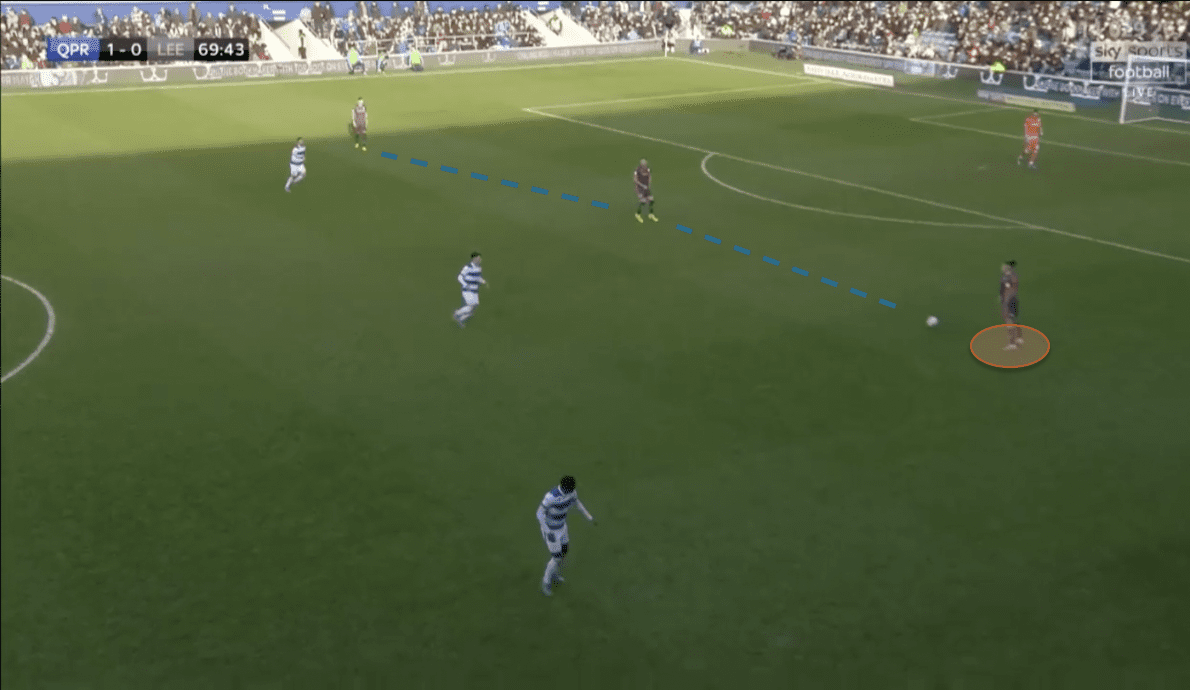
From a tactical perspective, when Phillips is playing as a centre-back in the build-up, the positioning of the Leeds players looks something like this:
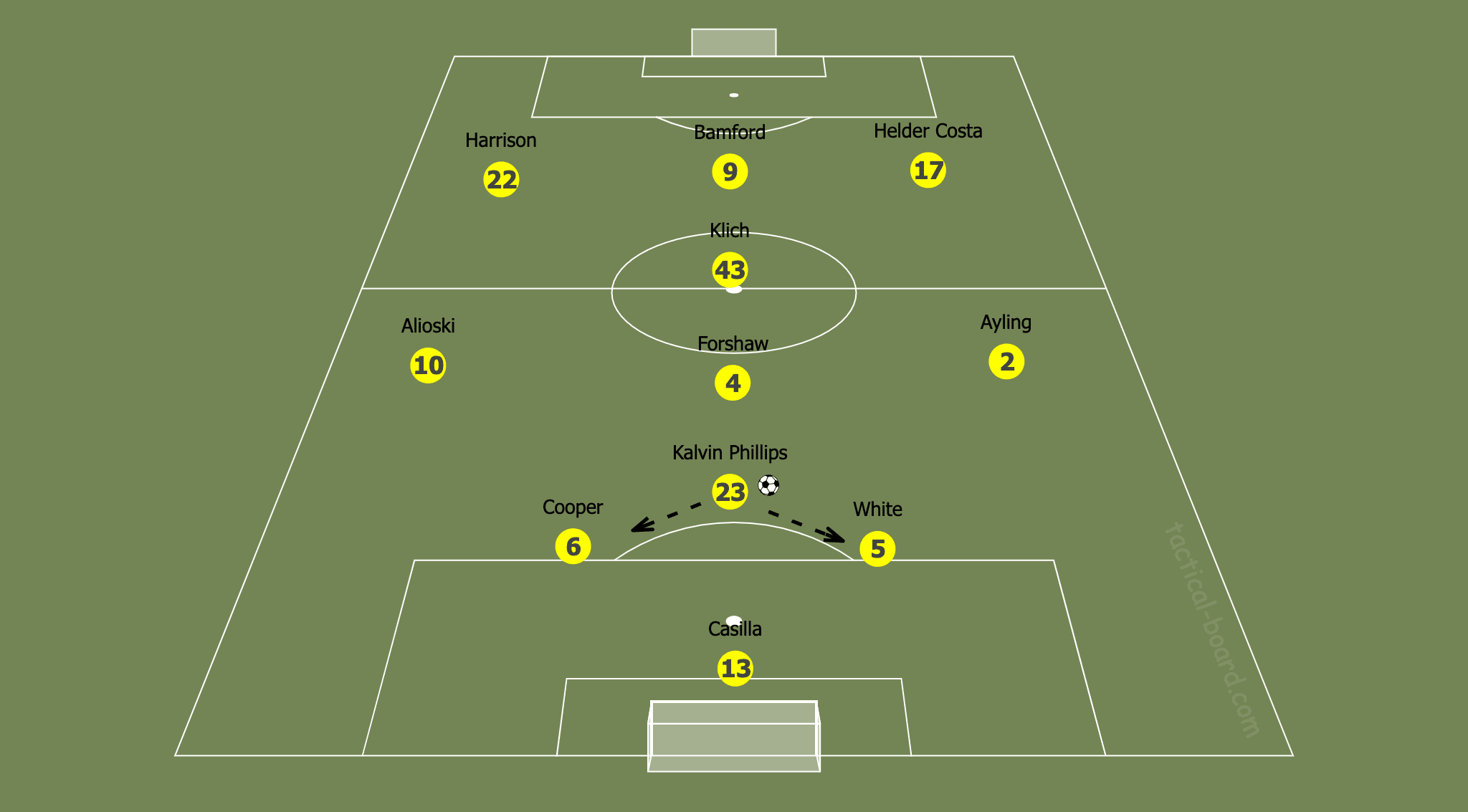
Usually, Phillips positions himself between the two centre-backs, although there are cases where he can operate as either a right—or left-sided centre-back, like in the image above.
From there, he can dictate the team’s play and act as a kind of “metronome,” directing attacks between the centre-backs and the rest of the team.
The second variant is that one of the fullbacks stays with two centre-backs, and Phillips keeps his midfield spot.
In this scenario, one of the two centre-backs passes the ball to Phillips, who then distributes it further.
At this moment, it’s worth mentioning how press-resilient Phillips is.
Almost always, when he gets the ball in his midfield position during the build-up, he is immediately challenged from the back.
He is able to either find a teammate to pass to or to get fouled, keeping the ball for the team.
He is very strong physically, so it is hard to push him off the ball.
Plus, he knows how to put his body in the right position to win a foul.
When pressed from the back, he rarely makes mistakes, which is very important because every mistake at this stage of attack has a high cost.
We can see an example of Phillips playing under pressure below:
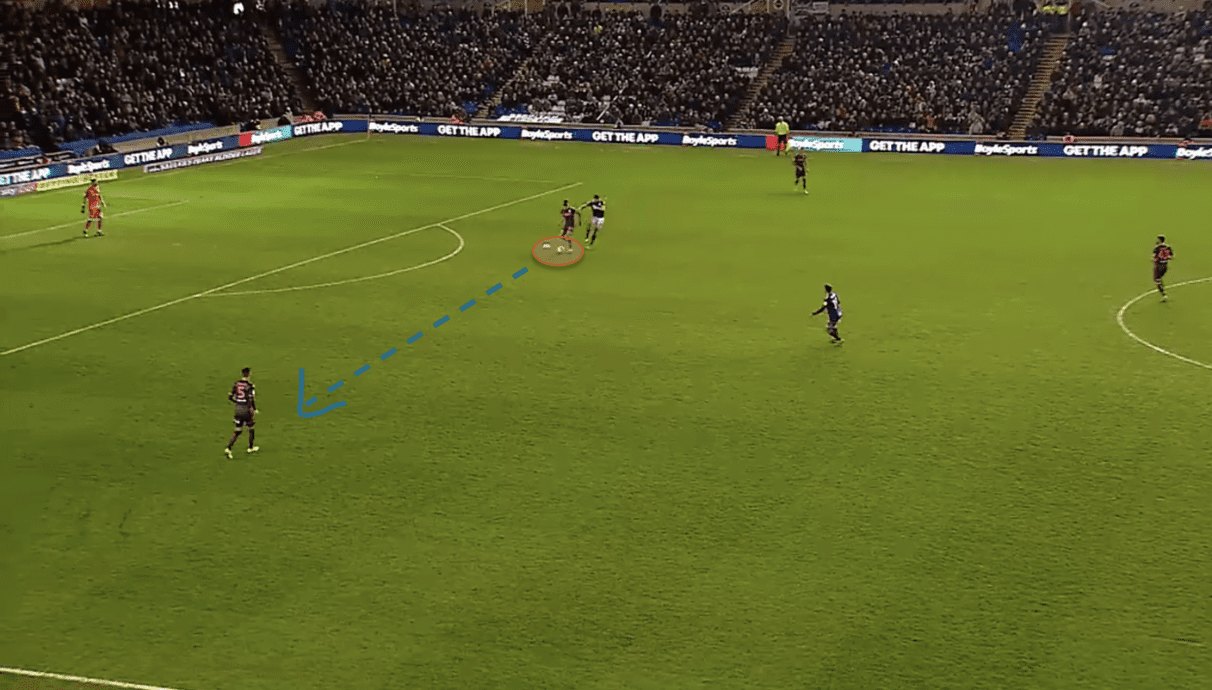
Kalvin Phillips Passing Abilities
A defensive midfielder with great passing abilities was always an important part of teams coached by Marcelo Bielsa.
Kalvin Phillips is precisely that kind of player: good on the ball with great vision and technique.
Bielsa is known for his ability to develop players and discover new qualities in them.
The 24-year-old Phillips definitely falls into that category.
If there were any questions about his class and talent last season, now he is proving himself as the best all-round midfielder in the second-tier league of English football.
He’s made progress under Bielsa, becoming the man with the most passes per game in this Leeds squad and a focal point in any attack.
There is no perfect replacement for him in Leeds United, so it won’t come as a surprise that he started all 27 Championship games this season, getting substituted in only two of them.
Here you can see all his pass distribution across the pitch this season:
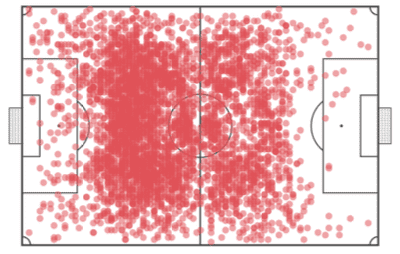
As mentioned earlier, Phillips plays a vital role at the beginning of any attack, whether from a centre-back or midfield spot.
He has a wide range of passes and can find a teammate anywhere on the pitch.
Phillips is a connecting link of Leeds’s attacks, providing the midfielders and full-backs with passes.
When he is playing as a midfielder in the build-up, he tries to position himself closer to the ball.
If Ayling or Alioski, two full-backs, are on the ball, Phillips usually runs closer to them to add a passing option and help bypass the opposition press.
We can see this movement in the image below:
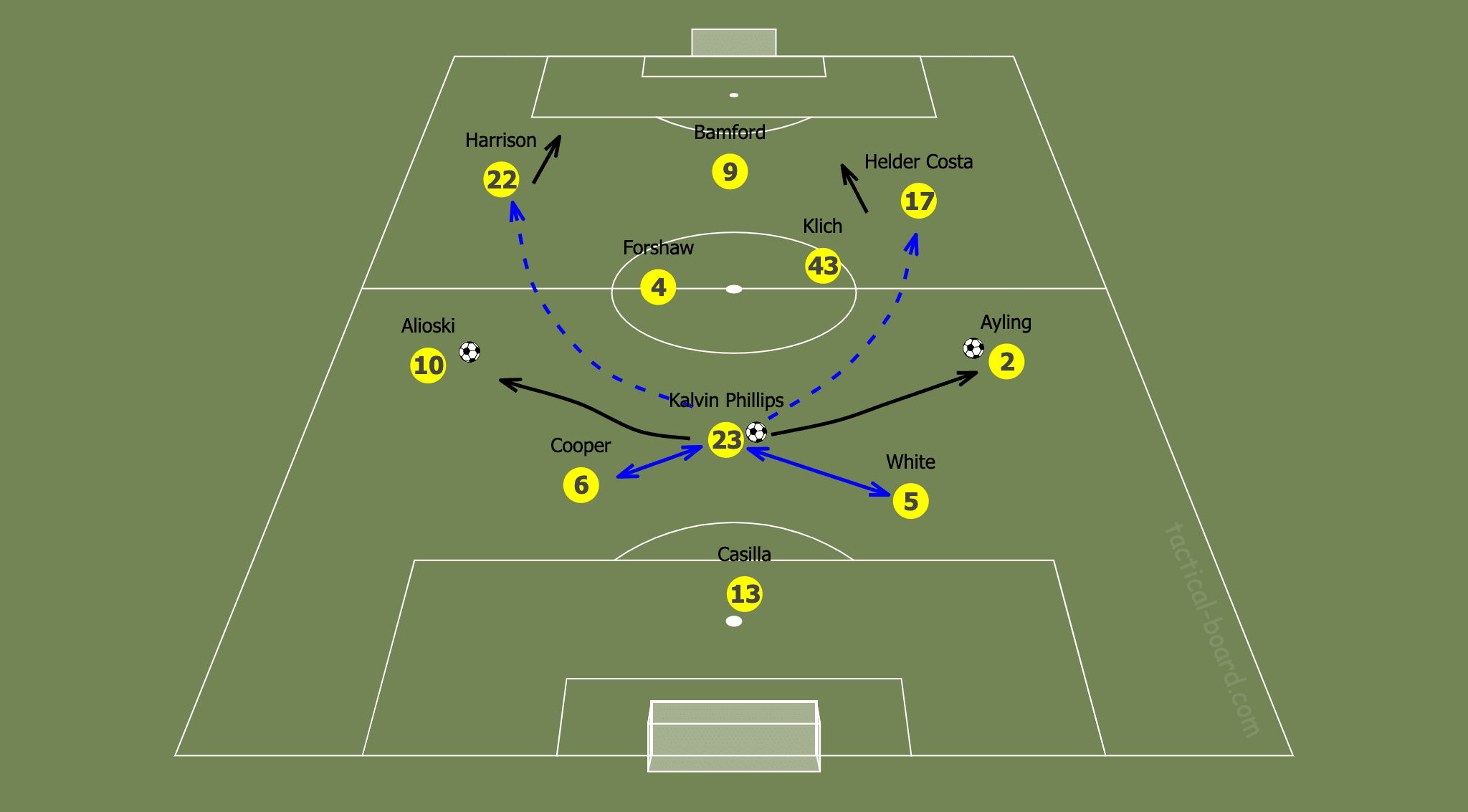
You can tell that the fullbacks are becoming wing-backs in possession, so Phillips has to accomplish a tremendous amount of work only to help his teammates progress the ball.
After he gets the ball from either Ayling or Alioski, he passes it to centre-backs or to another full-back immediately, helping stretch the opposition and create space.
This movement and the amount of running work allow his team to have space to attack and move the ball forward.
Also, Phillips is good at long distribution.
So, in addition to simple passes to the nearest teammate, he can make long passes to the wingers Costa, Harrison, or even Bamford.
On average, he makes 7 long passes per game with over 50% accuracy.
If he sees Helder Costa, Harrison or any of the attackers making a run, he can find them with great technique:
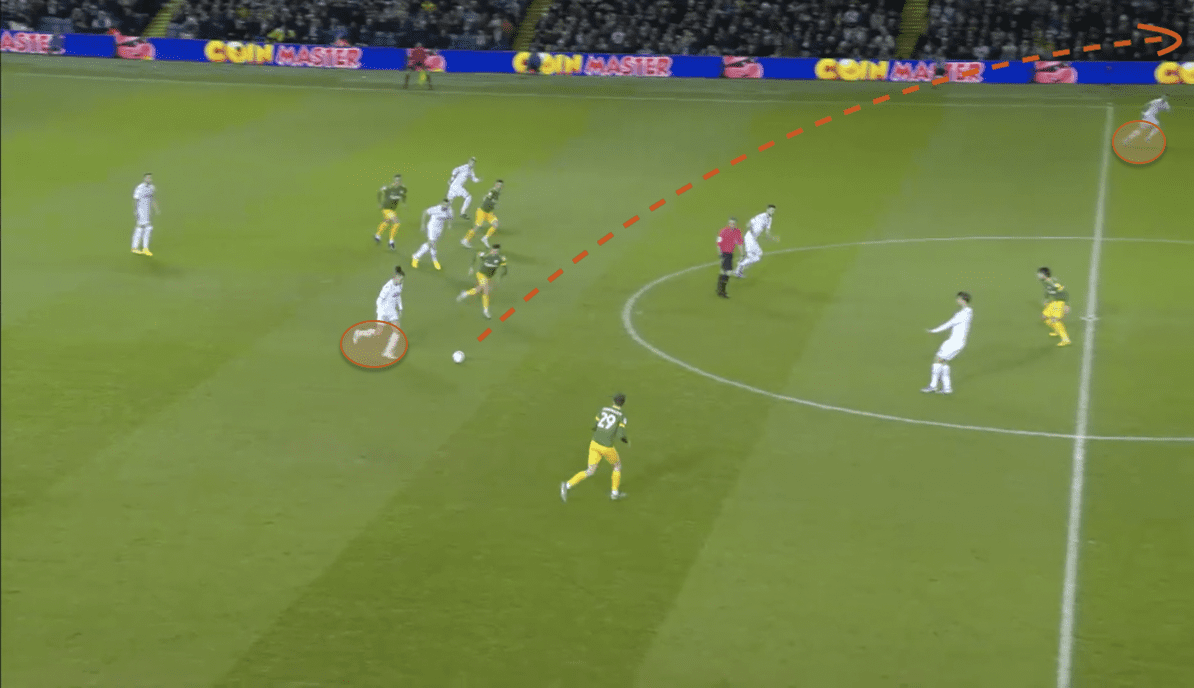
It is a valuable asset for a midfielder of his duties to have, as it provides an additional threat to the opposition defence, so they always have to track the runs of Leeds attackers.
This ability, as previously mentioned, also allows him to make long diagonal passes, switching the game from one flank to the other.
This, once again, allows to create space and disrupt the opposition press.
Overall, Phillips has met all the requirements that Bielsa demanded from him in the passing department, and it is hard to imagine how Leeds will cope with his absence because of a 3-match suspension.
Kalvin Phillips Defending Abilities
Kalvin Phillips is a unique player.
While playing in a dominating side that always controls most of the possession, he is also one of the best defensive players in the Championship.
It shows that despite his team mostly playing with the ball, he is the main man when it comes to defending (apart from centre-backs, of course).
He is averaging 12 recoveries per game in the opposition half with a success rate of nearly over 40%.
This is another indicator of his progress under Marcelo Bielsa, as he almost doubled his results from last season (from 7 per game).
He upgraded his game in this area, and that’s exactly what his coach needed from him defensively.
It is an astonishing figure, given that he is not defending most of the time.
Practically all of his recoveries happen in the middle third, as this is where he plays the majority of any match.
So, when the opposition team starts an attack, he is always ready to tackle:
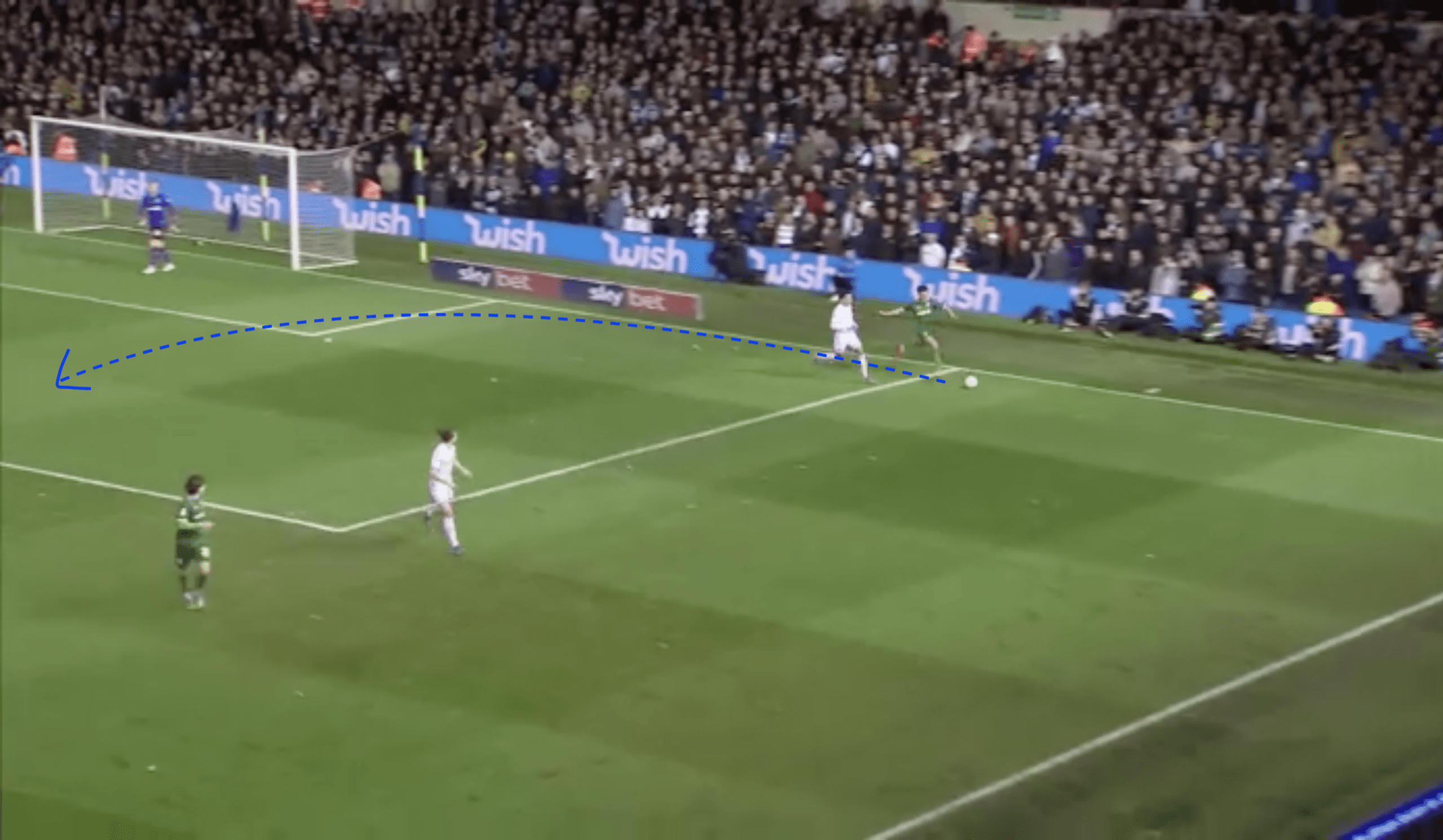
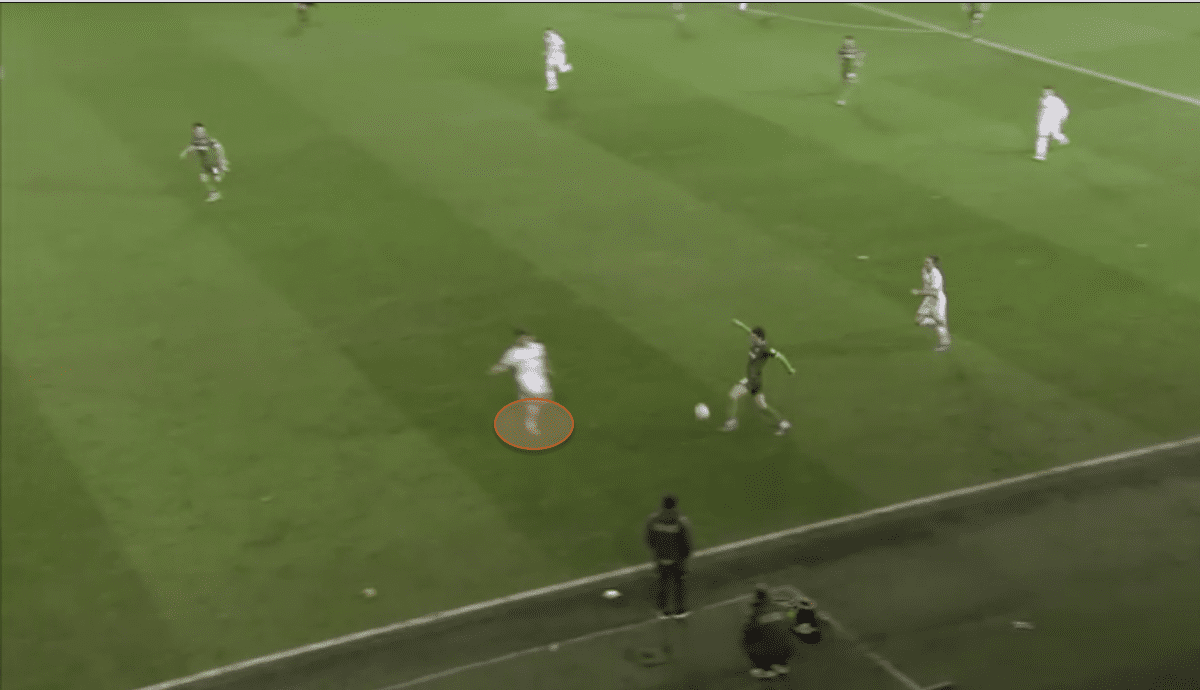
Counter-pressing is an important part of Bielsa’s tactics, so the goal is always to recover the ball as quickly as possible.
Phillips is also good at predicting possible passes, reading the opposition and positioning himself to intercept the ball.
On average, he makes around 4 interceptions per game this season.
Sometimes, it can be 9, just like in the recent game against Arsenal.
You can see one example below:
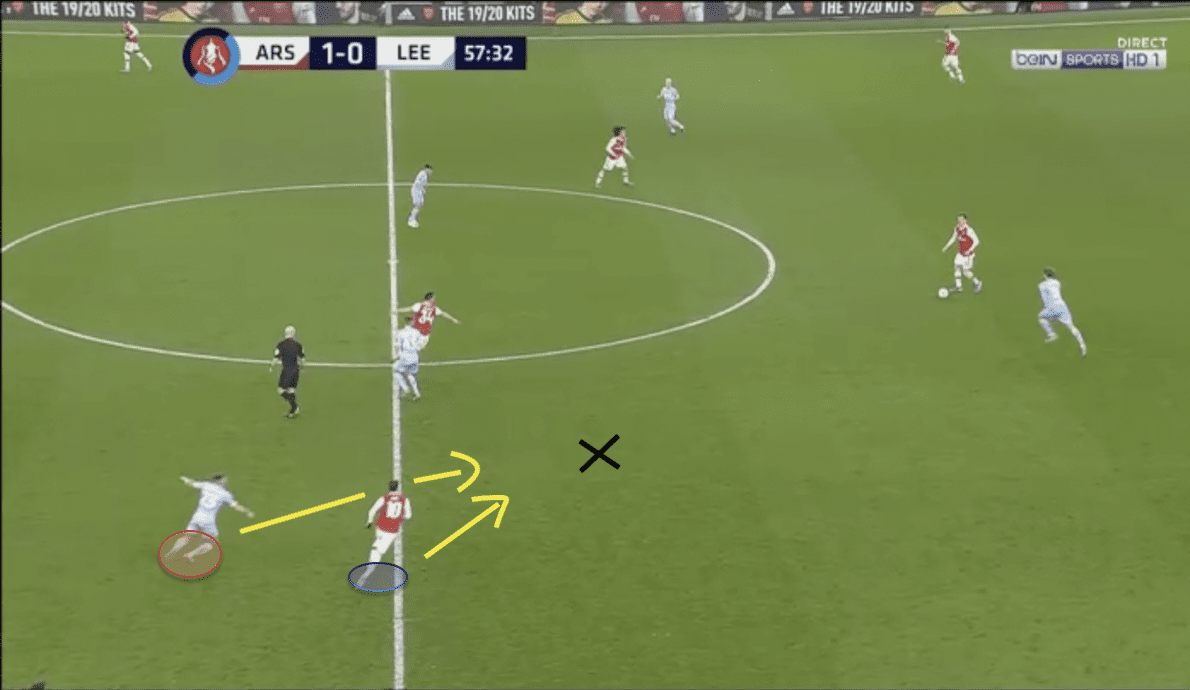
Another dimension of Phillips’ defensive play that is surely worth mentioning is his tackling and putting pressure on opponents in general.
We previously mentioned Phillips’s ability to read the game, and he uses it in almost every aspect of his defensive play.
When the opponent is preparing to receive a pass, Phillips is already putting pressure on him.
So, the player is immediately forced to make a decision and play a pass back or get fouled.
Phillips knows how to make tactical fouls, and that is very helpful, given that more than five Leeds players are joining every attack.
So, Leeds is not exposed by a counterattack and has the time to get back into defensive shape.
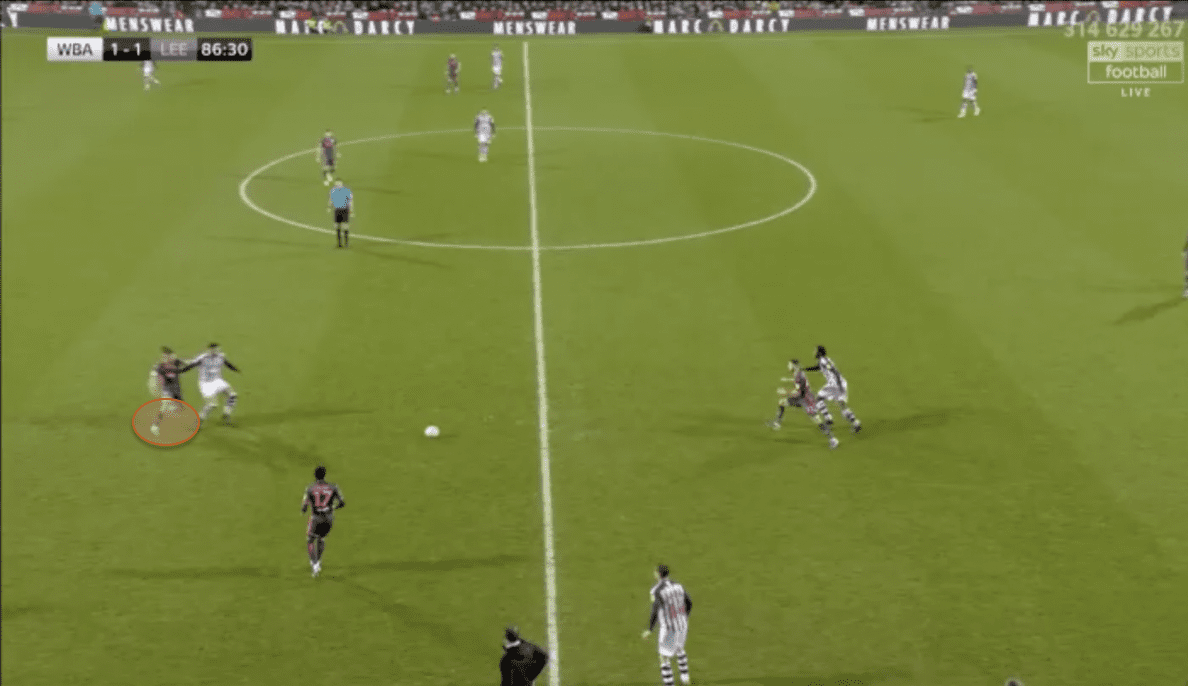
This pattern is not only applicable for stopping counter-attacks.
Phillips also uses it when his team is defending a normal, possession-based attack.
When he anticipates the possible pass, he immediately gets closer to the receiving player.
It is important that Phillips is picking the right player to put pressure on.
It’s because while doing that he leaves a lot of space behind him, so if he gets passed, it won’t be any good.
Just like with recoveries and interceptions, he makes a
large number of tackles—2.9 per game, to be exact.
So it is around 3 times per match that Phillips stops the opposition attack through tackling.
He has a certain pattern of how he makes those tackles.
When the opponent with the ball is running through, he forces the opposition player to go down the flank by following him.
There are several options: a player is turning around and passes the ball backwards; a player is turning around, and Phillips either tackles him or fouls.
There are rare occasions when the opponent is able to run through the wing.
However, he still gets pressured by one of the defenders and eventually loses the ball.
This movement is smart and makes the player lose the ball as the touchline becomes one more defender, limiting the space for the opposition to run through.
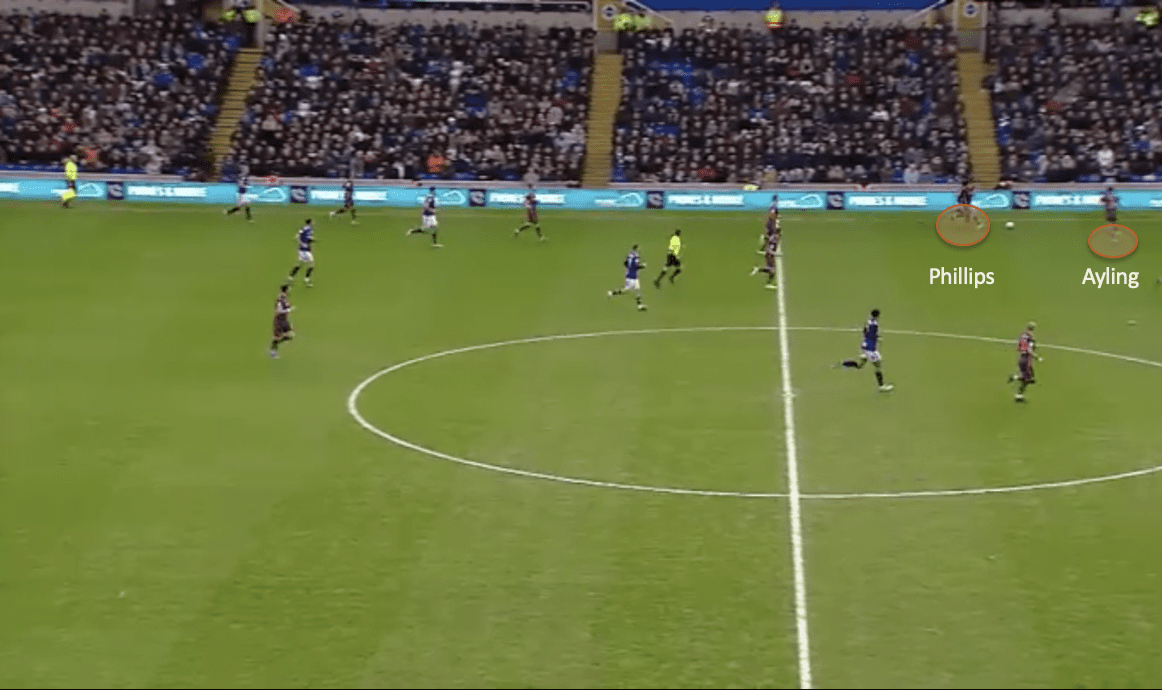
He is a defensive colossus, a giant who holds the squad together, allowing Bielsa’s tactics to thrive at Leeds.
He opens up the opportunity for full-backs and midfielders to join the attack while covering a huge area of the pitch himself.
With clever positioning and an unquestionable work ethic he does his job brilliantly, as we saw previously.
With such a defensive masterclass shown to Arsenal in the FA Cup, he showed that he and his team are ready for playing in the highest division.
Where Kalvin Phillips needs to improve
So far, I’ve described Kalvin Phillips as a flawless player and vital part of the team.
However, he also has his drawbacks.
The first one is his attacking output.
Of course, it is by far not the most important thing for the player in his profile, especially given his role on his team.
Nonetheless, he scored only one goal this season, the same as last season, and he went six games without a single shot.
In the 2017/18 season, before Bielsa, he scored 7 goals in all competitions, so he definitely can score.
You’d expect a player of his talent to try and hit it outside the box here and there, but even this is not happening currently.
Another negative thing that I want to point out is fouls.
As we saw earlier in this scout report, Phillips is excellent at tactical fouls, and he helps his team by doing so.
But sometimes, he goes over the edge with that.
For example, in the last game that Leeds played against QPR, Phillips was sent off and got suspended for three matches after a horrific tackle on Geoff Cameron.
I am pretty sure that this is a rare accident and that it won’t happen again, but it shows that Phillips can harm his team even if he is attempting to do his best.
Conclusion
From this tactical analysis, you hopefully learned a lot about Kalvin Phillips’s style of play.
With Leeds getting Jean-Kevin Augustin and becoming an increasingly obvious contender for the Championship title or at least automatic promotion, Kalvin Phillips’ future looks bright.
His club can be promoted to the Premier League for the first time in more than ten years.
Together with getting gold medals, Phillips has another objective in mind: getting a Euros call-up.
He has never played for England at any level or in any age group, so it may seem really exciting to get to play for the main England squad straight away.
The chance for him to fulfil his dream is not miserable, as Gareth Southgate attended Leeds’ recent game against Sheffield Wednesday, keeping a close look at a potential English midfielder.
England called up retired goalkeeper Paul Robinson as the last player from Leeds, and there is a fair chance that Phillips could be the next one.
However, his main focus remains getting a long-awaited promotion for his boyhood club, so we will have to see how it plays out for him and his team.





Comments